Abstract
1. The pharmacological profile of GR94839, a kappa-opioid agonist with limited access to the central nervous system, has been investigated. Its antinociceptive activity has been compared with that of GR103545, a centrally-penetrating kappa-agonist and ICI204448, the previously described peripherally-selective kappa-agonist. 2. GR94839 was a potent agonist in the rabbit vas deferens in vitro assay for kappa-opioid receptors (IC50: 1.4 +/- 0.3 nM; n = 6), but had limited activity at mu- or delta-opioid receptors. 3. In the mouse abdominal constriction test, GR94839 was 238 fold more potent when given i.c.v. (ED50: 0.008 (0.004-0.029) mg kg-1; n = 18) than when s.c. (ED50: 1.9 (0.7-3.1) mg kg-1; n = 30). In comparison, GR103545 was equipotent when given i.c.v. or s.c. 4. After intravenous administration, the maximum plasma to brain concentration-ratio attained by GR94839 was 18 compared with 2 for GR85571, a structurally-related kappa-agonist that is centrally-penetrating. 5. GR94839 inhibited the 2nd phase of the rat formalin response at doses 7 fold lower than those required to inhibit the 1st phase (ED50 vs 1st phase: 10.2 (6.7-17.1) mg kg-1, s.c.; ED50 vs 2nd phase: 1.4 (1.0-1.8) mg kg-1, s.c.; n = 18). GR103545 was equipotent against the two phases. 6. Intraplantar administration of the opioid antagonists, norbinaltorphimine (100 micrograms) or naltrexone (1 microgram), reversed the antinociceptive effect of systemic GR94839 (3 mg kg-1, s.c.) against the 2nd phase of the formalin response and intraplantar injection of GR94839 (30-100 micrograms) selectively inhibited the 2nd phase.(ABSTRACT TRUNCATED AT 250 WORDS)
Full text
PDF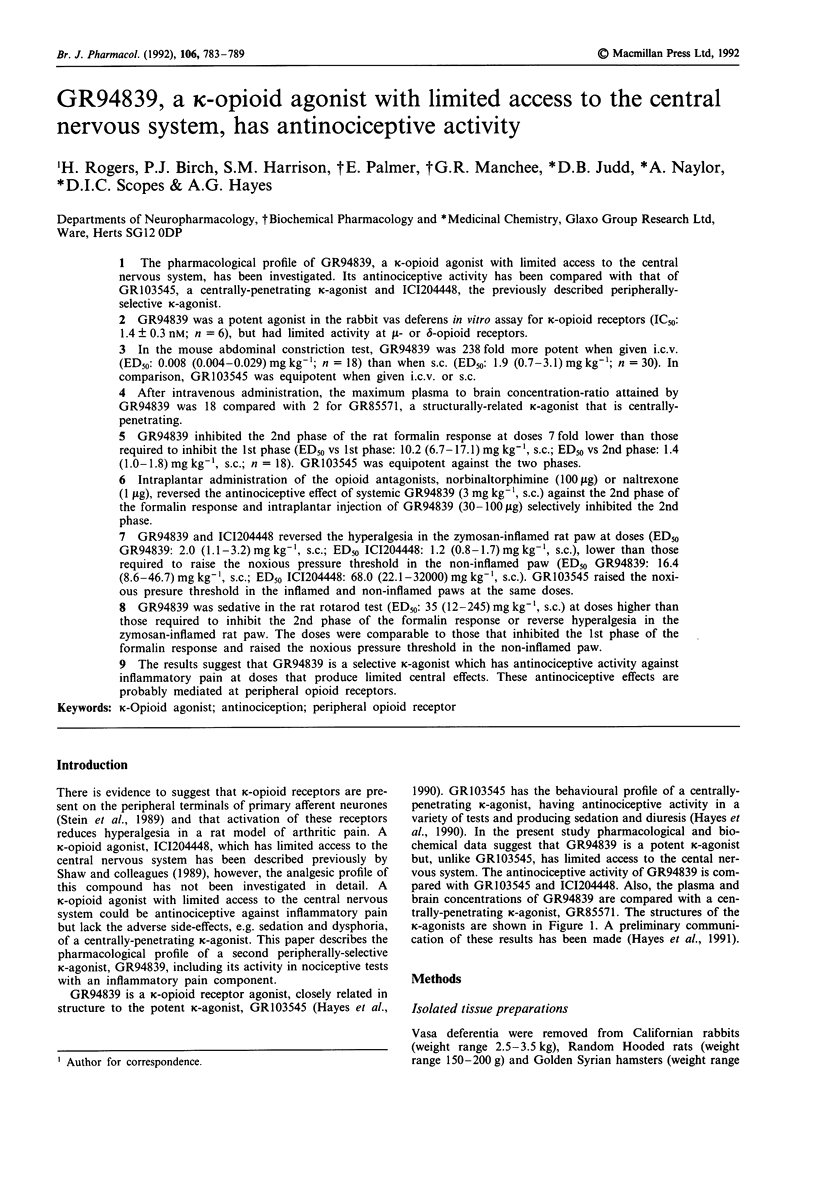
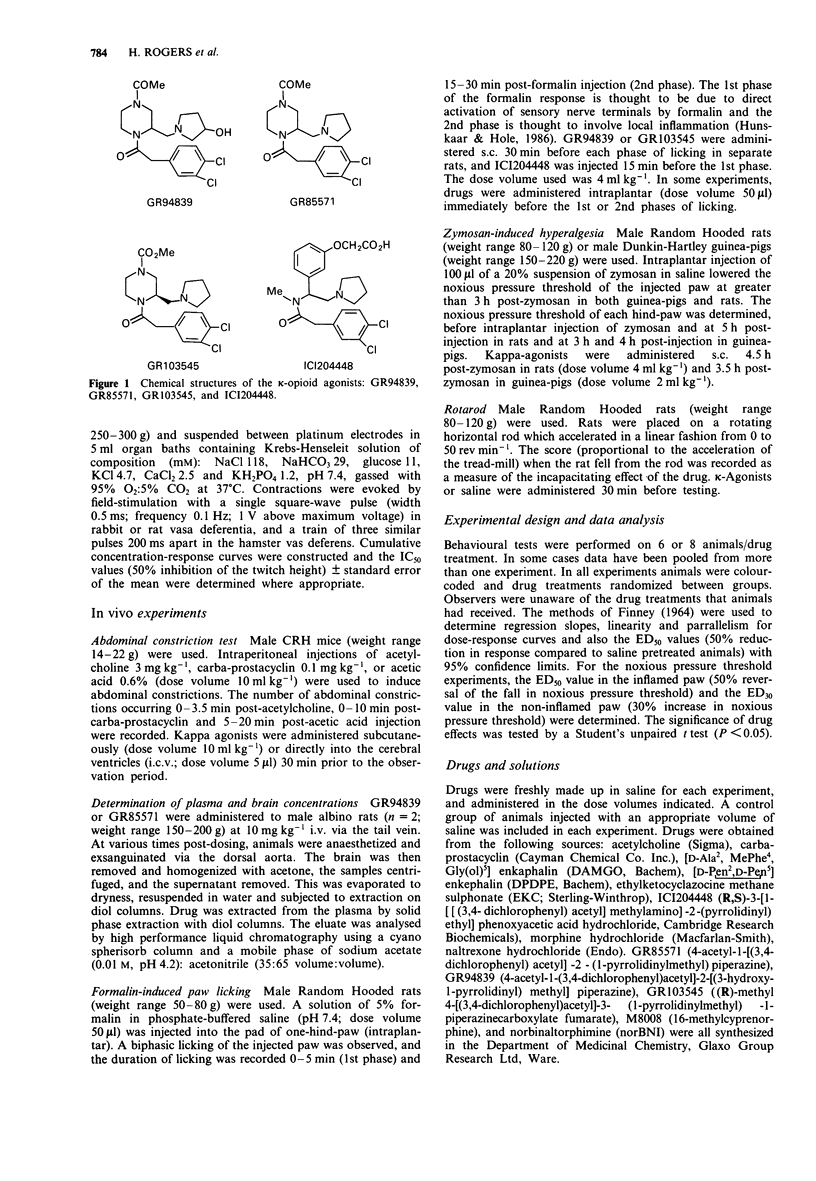

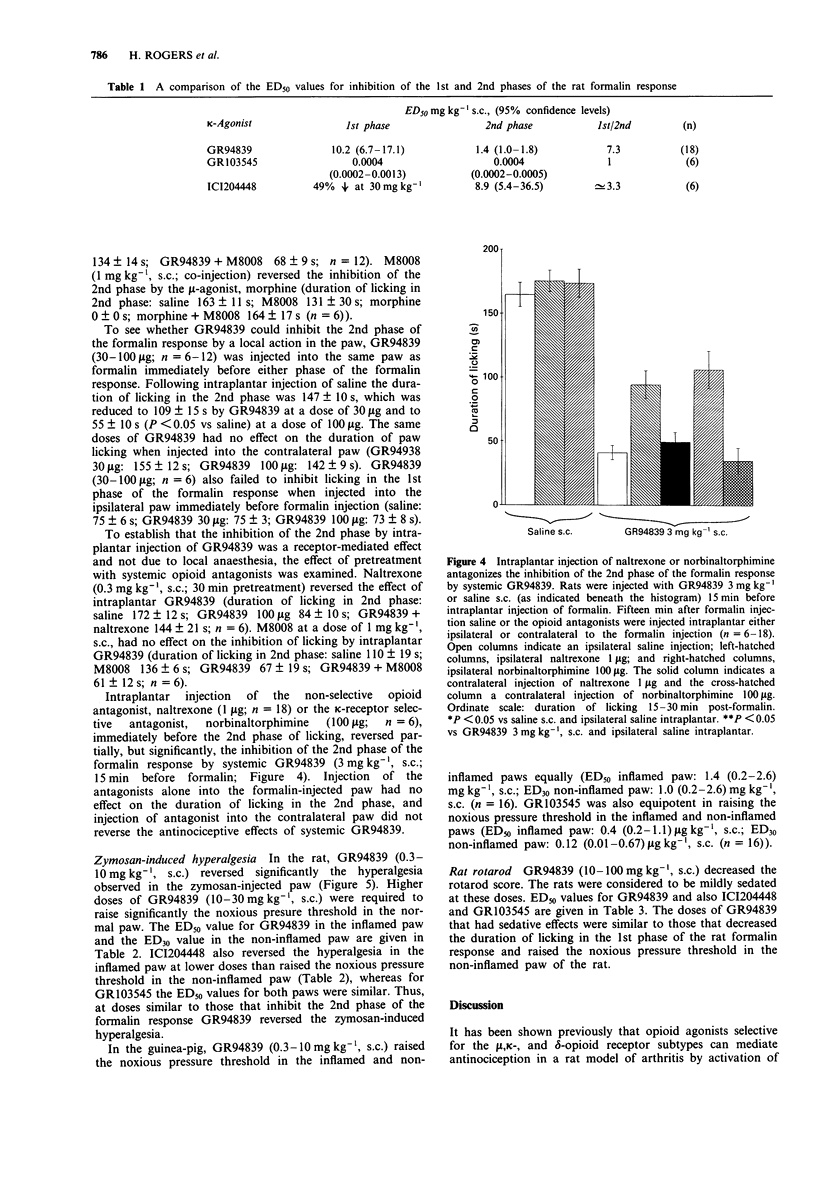
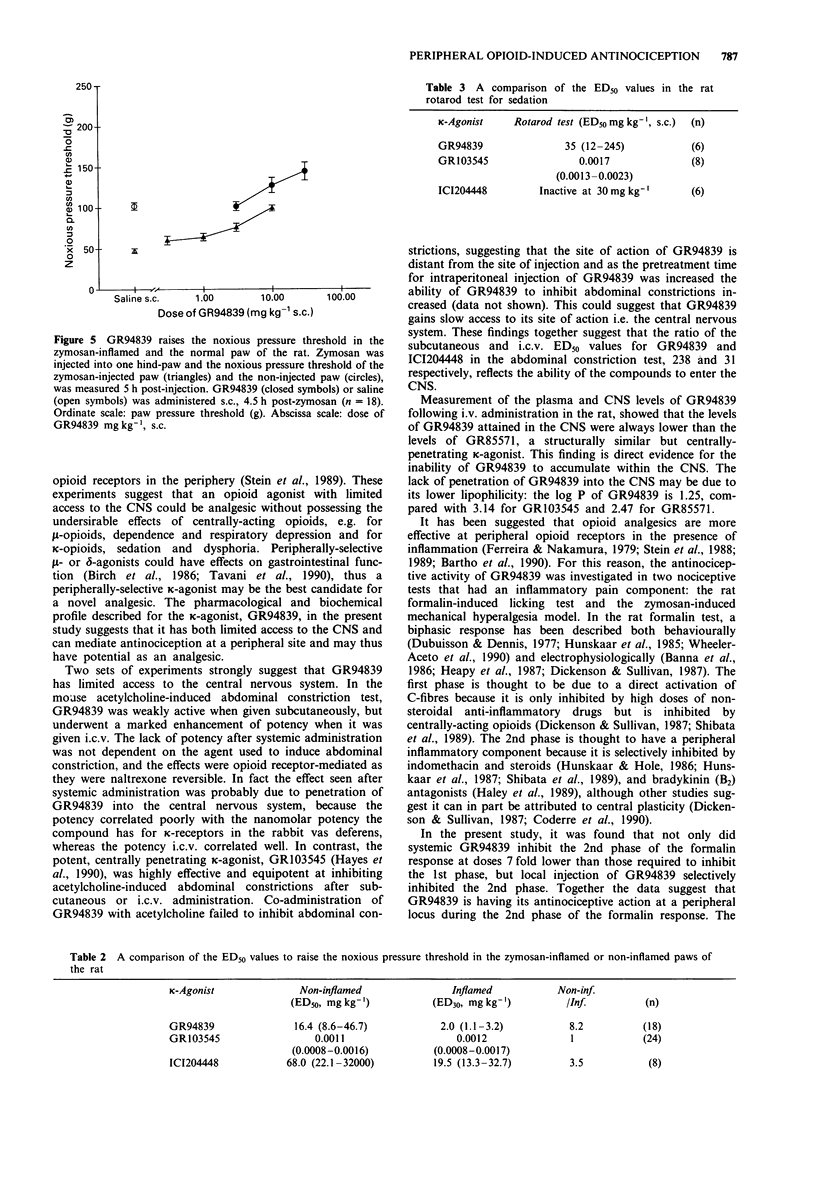
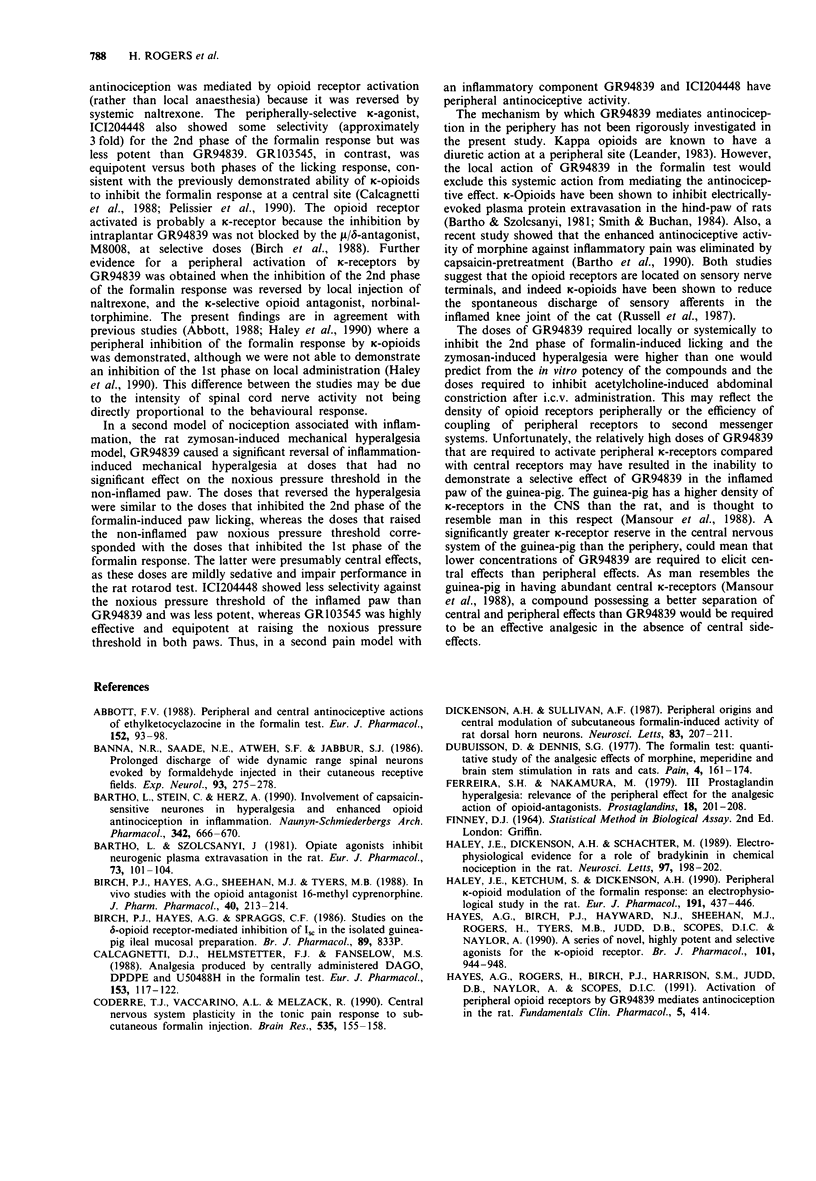
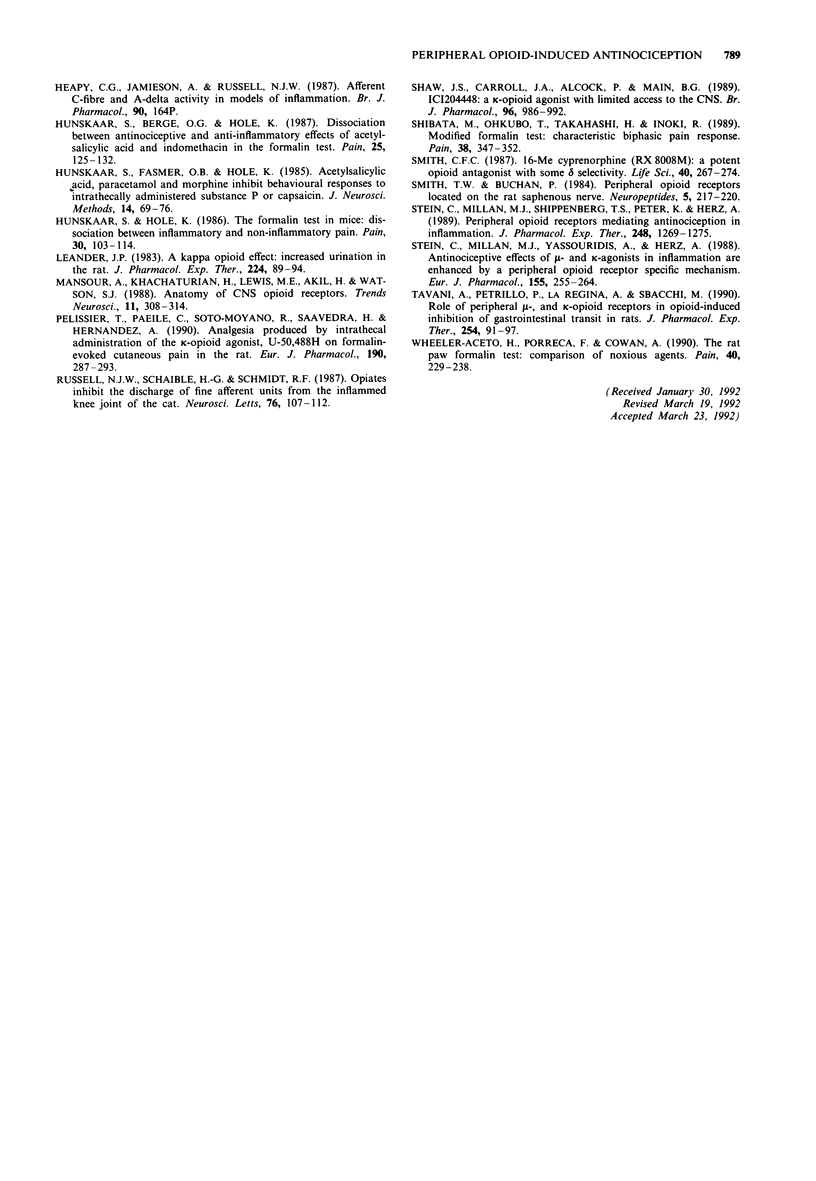
Selected References
These references are in PubMed. This may not be the complete list of references from this article.
- Abbott F. V. Peripheral and central antinociceptive actions of ethylketocyclazocine in the formalin test. Eur J Pharmacol. 1988 Jul 26;152(1-2):93–100. doi: 10.1016/0014-2999(88)90839-4. [DOI] [PubMed] [Google Scholar]
- Banna N. R., Saadé N. E., Atweh S. F., Jabbur S. J. Prolonged discharge of wide-dynamic-range spinal neurons evoked by formaldehyde injected in their cutaneous receptive fields. Exp Neurol. 1986 Jul;93(1):275–278. doi: 10.1016/0014-4886(86)90165-2. [DOI] [PubMed] [Google Scholar]
- Barthó L., Stein C., Herz A. Involvement of capsaicin-sensitive neurones in hyperalgesia and enhanced opioid antinociception in inflammation. Naunyn Schmiedebergs Arch Pharmacol. 1990 Dec;342(6):666–670. doi: 10.1007/BF00175710. [DOI] [PubMed] [Google Scholar]
- Barthó L., Szolcsányi J. Opiate agonists inhibit neurogenic plasma extravasation in the rat. Eur J Pharmacol. 1981 Jul 17;73(1):101–104. doi: 10.1016/0014-2999(81)90152-7. [DOI] [PubMed] [Google Scholar]
- Birch P. J., Hayes A. G., Sheehan M. J., Tyers M. B. In-vivo studies with the opioid antagonist, 16-methylcyprenorphine. J Pharm Pharmacol. 1988 Mar;40(3):213–214. doi: 10.1111/j.2042-7158.1988.tb05224.x. [DOI] [PubMed] [Google Scholar]
- Calcagnetti D. J., Helmstetter F. J., Fanselow M. S. Analgesia produced by centrally administered DAGO, DPDPE and U50488H in the formalin test. Eur J Pharmacol. 1988 Aug 9;153(1):117–122. doi: 10.1016/0014-2999(88)90595-x. [DOI] [PubMed] [Google Scholar]
- Coderre T. J., Vaccarino A. L., Melzack R. Central nervous system plasticity in the tonic pain response to subcutaneous formalin injection. Brain Res. 1990 Dec 3;535(1):155–158. doi: 10.1016/0006-8993(90)91835-5. [DOI] [PubMed] [Google Scholar]
- Dickenson A. H., Sullivan A. F. Peripheral origins and central modulation of subcutaneous formalin-induced activity of rat dorsal horn neurones. Neurosci Lett. 1987 Dec 16;83(1-2):207–211. doi: 10.1016/0304-3940(87)90242-4. [DOI] [PubMed] [Google Scholar]
- Dubuisson D., Dennis S. G. The formalin test: a quantitative study of the analgesic effects of morphine, meperidine, and brain stem stimulation in rats and cats. Pain. 1977 Dec;4(2):161–174. doi: 10.1016/0304-3959(77)90130-0. [DOI] [PubMed] [Google Scholar]
- Ferreira S. H., Nakamura M. III - Prostaglandin hyperalgesia: relevance of the peripheral effect for the analgesic action of opioid-antagonists. Prostaglandins. 1979 Aug;18(2):201–208. doi: 10.1016/0090-6980(79)90105-9. [DOI] [PubMed] [Google Scholar]
- Haley J. E., Dickenson A. H., Schachter M. Electrophysiological evidence for a role of bradykinin in chemical nociception in the rat. Neurosci Lett. 1989 Feb 13;97(1-2):198–202. doi: 10.1016/0304-3940(89)90163-8. [DOI] [PubMed] [Google Scholar]
- Haley J., Ketchum S., Dickenson A. Peripheral kappa-opioid modulation of the formalin response: an electrophysiological study in the rat. Eur J Pharmacol. 1990 Dec 4;191(3):437–446. doi: 10.1016/0014-2999(90)94178-z. [DOI] [PubMed] [Google Scholar]
- Hayes A. G., Birch P. J., Hayward N. J., Sheehan M. J., Rogers H., Tyers M. B., Judd D. B., Scopes D. I., Naylor A. A series of novel, highly potent and selective agonists for the kappa-opioid receptor. Br J Pharmacol. 1990 Dec;101(4):944–948. doi: 10.1111/j.1476-5381.1990.tb14185.x. [DOI] [PMC free article] [PubMed] [Google Scholar]
- Hunskaar S., Berge O. G., Hole K. Dissociation between antinociceptive and anti-inflammatory effects of acetylsalicylic acid and indomethacin in the formalin test. Pain. 1986 Apr;25(1):125–132. doi: 10.1016/0304-3959(86)90014-X. [DOI] [PubMed] [Google Scholar]
- Hunskaar S., Fasmer O. B., Hole K. Formalin test in mice, a useful technique for evaluating mild analgesics. J Neurosci Methods. 1985 Jun;14(1):69–76. doi: 10.1016/0165-0270(85)90116-5. [DOI] [PubMed] [Google Scholar]
- Hunskaar S., Hole K. The formalin test in mice: dissociation between inflammatory and non-inflammatory pain. Pain. 1987 Jul;30(1):103–114. doi: 10.1016/0304-3959(87)90088-1. [DOI] [PubMed] [Google Scholar]
- Leander J. D. A kappa opioid effect: increased urination in the rat. J Pharmacol Exp Ther. 1983 Jan;224(1):89–94. [PubMed] [Google Scholar]
- Mansour A., Khachaturian H., Lewis M. E., Akil H., Watson S. J. Anatomy of CNS opioid receptors. Trends Neurosci. 1988 Jul;11(7):308–314. doi: 10.1016/0166-2236(88)90093-8. [DOI] [PubMed] [Google Scholar]
- Pelissier T., Paeile C., Soto-Moyano R., Saavedra H., Hernández A. Analgesia produced by intrathecal administration of the kappa opioid agonist, U-50,488H, on formalin-evoked cutaneous pain in the rat. Eur J Pharmacol. 1990 Nov 13;190(3):287–293. doi: 10.1016/0014-2999(90)94192-z. [DOI] [PubMed] [Google Scholar]
- Russell N. J., Schaible H. G., Schmidt R. F. Opiates inhibit the discharges of fine afferent units from inflamed knee joint of the cat. Neurosci Lett. 1987 Apr 23;76(1):107–112. doi: 10.1016/0304-3940(87)90201-1. [DOI] [PubMed] [Google Scholar]
- Shaw J. S., Carroll J. A., Alcock P., Main B. G. ICI 204448: a kappa-opioid agonist with limited access to the CNS. Br J Pharmacol. 1989 Apr;96(4):986–992. doi: 10.1111/j.1476-5381.1989.tb11911.x. [DOI] [PMC free article] [PubMed] [Google Scholar]
- Shibata M., Ohkubo T., Takahashi H., Inoki R. Modified formalin test: characteristic biphasic pain response. Pain. 1989 Sep;38(3):347–352. doi: 10.1016/0304-3959(89)90222-4. [DOI] [PubMed] [Google Scholar]
- Smith C. F. 16-Me cyprenorphine (RX 8008M): a potent opioid antagonist with some delta selectivity. Life Sci. 1987 Jan 19;40(3):267–274. doi: 10.1016/0024-3205(87)90342-0. [DOI] [PubMed] [Google Scholar]
- Smith T. W., Buchan P. Peripheral opioid receptors located on the rat saphenous nerve. Neuropeptides. 1984 Dec;5(1-3):217–220. doi: 10.1016/0143-4179(84)90066-0. [DOI] [PubMed] [Google Scholar]
- Stein C., Millan M. J., Shippenberg T. S., Peter K., Herz A. Peripheral opioid receptors mediating antinociception in inflammation. Evidence for involvement of mu, delta and kappa receptors. J Pharmacol Exp Ther. 1989 Mar;248(3):1269–1275. [PubMed] [Google Scholar]
- Stein C., Millan M. J., Yassouridis A., Herz A. Antinociceptive effects of mu- and kappa-agonists in inflammation are enhanced by a peripheral opioid receptor-specific mechanism. Eur J Pharmacol. 1988 Oct 18;155(3):255–264. doi: 10.1016/0014-2999(88)90511-0. [DOI] [PubMed] [Google Scholar]
- Tavani A., Petrillo P., La Regina A., Sbacchi M. Role of peripheral mu, delta and kappa opioid receptors in opioid-induced inhibition of gastrointestinal transit in rats. J Pharmacol Exp Ther. 1990 Jul;254(1):91–97. [PubMed] [Google Scholar]
- Wheeler-Aceto H., Porreca F., Cowan A. The rat paw formalin test: comparison of noxious agents. Pain. 1990 Feb;40(2):229–238. doi: 10.1016/0304-3959(90)90073-M. [DOI] [PubMed] [Google Scholar]


